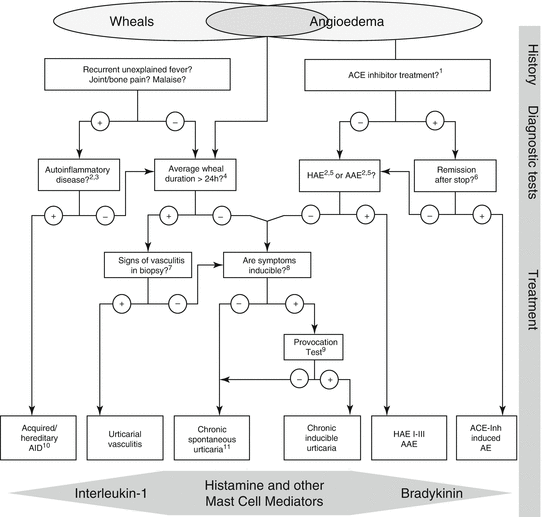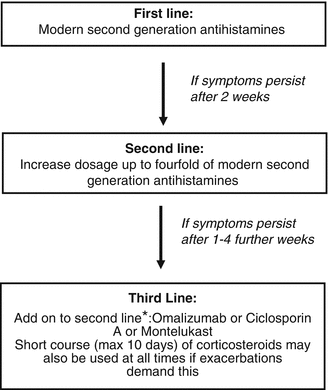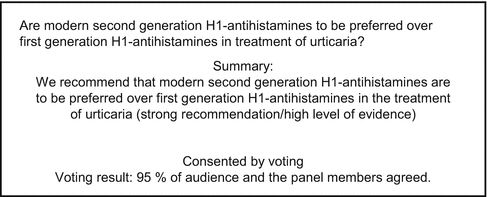Urticaria interferes with my social relationship
67.11 %
I feel embarrassed by urticaria signs on my body
84.21 %
I’m embarrassed in going to public places understanding the personal impact is thus important for the management
72.37 %
8.4 Diagnosis
The guidelines obviously provide a rational approach for the diagnosis of urticaria based on the typical patient and is also based on a concept of an economic use of resources in medicine. The guidelines however also leave freedom for the decision and emphasize that based on the history of the patient, additional diagnostic procedures may be warranted and are mentioned as an extended diagnostic program in Fig. 8.1 [1]:


Fig. 8.1
Recommended diagnostic algorithm for patients presenting with wheals, angioedema, or both. AAE acquired angioedema due to C1-inhibitor deficiency, ACE-Inh angiotensin-converting enzyme inhibitor, AE angioedema, AH antihistamine, AID autoinflammatory disease, HAE hereditary angioedema, IL–1 interleukin-1
1. | Other (new) drugs may also induce bradykinin-mediated angioedema. |
2. | Patients should be asked for a detailed family history and age of disease onset. |
3. | Test for elevated inflammation markers (C-reactive protein, erythrocyte sedimentation rate), test for paraproteinemia in adults, look for signs of neutrophil-rich infiltrates in skin biopsy; perform gene mutation analysis of hereditary periodic fever syndromes (e.g., cryopyrin-associated periodic syndrome), if strongly suspected. |
4. | Patients should be asked: “How long do your wheals last?” |
5. | Test for complement C4 and C1-INH levels and function; in addition, test for C1q and C1-INH antibodies, if AAE is suspected; do gene mutation analysis, if former tests are unremarkable but patient’s history suggests hereditary angioedema. |
6. | Wait for up to 6 months for remission; additional diagnostics to test for C1-inhibitor deficiency should only be performed if the family history suggests hereditary angioedema. |
7. | Does the biopsy of lesional skin show damage of the small vessels in the papillary and reticular dermis and/or fibrinoid deposits in perivascular and interstitial locations suggestive of UV (urticarial vasculitis)? |
8. | Patients should be asked: “Can you make your wheals come?” |
9. | In patients with a history suggestive of inducible urticaria, standardized provocation testing according to international consensus recommendations [3] should be performed. |
10. | Acquired AIDs (autoinflammatory syndromes) include Schnitzler’s syndrome as well as systemic-onset juvenile idiopathic arthritis (sJIA) and adult-onset Still’s disease (AOSD); hereditary AIDs include cryopyrin-associated periodic syndromes (CAPS) such as familial cold autoinflammatory syndromes (FCAS), Muckle-Wells syndrome (MWS), and neonatal-onset multisystem inflammatory disease (NOMID), more rarely hyper-IgD syndrome (HIDS) and tumor necrosis factor receptor alpha-associated periodic syndrome (TRAPS). |
11. | In some rare cases, recurrent angioedema is neither mast cell mediator mediated nor bradykinin mediated, and the underlying pathomechanisms remain unknown. These rare cases are referred to as “idiopathic angioedema” by some authors. |
The guidelines also provide a list of questions which should be discussed with the patient to understand possible courses [1]:
1. | Time of onset of disease |
2. | Frequency/duration of and provoking factors for wheals |
3. | Diurnal variation |
4. | Occurrence in relation to weekends, holidays, and foreign travel |
5. | Shape, size, and distribution of wheals |
6. | Associated angioedema |
7. | Associated subjective symptoms of lesions, e.g., itch and pain |
8. | Family and personal history regarding urticaria and atopy |
9. | Previous or current allergies, infections, internal diseases, or other possible causes |
10. | Psychosomatic and psychiatric diseases |
11. | Surgical implantations and events during surgery, e.g., after local anesthesia |
12. | Gastric/intestinal problems |
13. | Induction by physical agents or exercise |
14. | Use of drugs (e.g., NSAIDs, injections, immunizations, hormones, laxatives, suppositories, ear and eye drops, and alternative remedies) |
15. | Observed correlation to food |
16. | Relationship to the menstrual cycle |
17. | Smoking habits (esp. use of perfumed tobacco products or cannabis) |
18. | Type of work |
19. | Hobbies |
20. | Stress (eustress and distress) |
21. | Quality of life related to urticaria and emotional impact |
22. | Previous therapy and response to therapy |
23. | Previous diagnostic procedures/results |
For the interested physician, it is useful to adapt and possibly extend these questions to a questionnaire which can then be handed out to the patient still in the waiting room. This allows a very quick overview of patient history and also allows the patient a time for reflection saving on the other hand time in the doctor’s office. For our urticaria clinic, we have extended the questionnaire to “100 questions on your urticaria.” The full questionnaire in English language can be found on the web page www.ecarf.org. In my own experience, taking a very thorough history based on this questionnaire in approximately 20 % of patients with chronic spontaneous urticaria, hidden courses can be detected. Some of them may even be worth to be published such as the use of aspirin as a preservative [4] which I have now discovered is also sometimes used in restaurants especially in Brazil, where salad is sprayed with an aspirin solution to prevent oxidation.
Another aspect which is frequently overlooked but can be discovered by the right questions is subtle underlying inflammatory processes. More severe diseases are certainly noticed by patients, but chronic inflammatory processes, e.g., chronic sinusitis, gastritis, or an inflammation of the bile duct, are often regarded as less noteworthy by patients. However they may be an important causative factor in urticaria. In this instance it is also important to mention that not only the infectious agent, e.g., Helicobacter pylori, themselves can be a trigger but also noninfectious inflammatory processes. This is well established for Helicobacter pylori-negative gastritis, and in my own experience, several patients recorded that the severity of urticaria symptoms correlates well with lifestyle factors which is having an impact on the severity of their gastritis as smoking or emotional distress.
While in chronic spontaneous urticaria, taking a history may reveal the triggering factor and allow a causal treatment, in inducible urticarias, in most instances the disease itself has to be regarded as idiopathic, and it is not helpful to go into an extensive diagnostic program. However also in these instances, a thorough history will help to better understand the situation of a patient and allow a better conception about the avoidance of triggering factors. Thus many patients, e.g., in pressure urticaria, have not really understood the correlation that pressure is defined by force per area and simple measurements like changing shoes and using cushioned soles or gloves may have a high impact. The same holds true for other subtypes of inducible urticarias, e.g., light urticaria, where consultation about the UV protection factor of clothes, the better understanding of their recreational habits, and the consultation about the proper use of sunscreens adapted to the wavelength which triggers the wheals is extremely helpful for patients. To offer a most perfect personalized treatment in the inducible physical urticaria subtypes, it is in general extremely important that the doctor pictures the daily life and also the working environment of the patients and knows the available items which can possibly give support, e.g., UV light protection screens for windows or specially worked tools causing less friction when being handled.
The guidelines propose a very clear and strict algorithm in treatment which is sufficient for the vast majority of patients, and a personalized approach is limited to those few patients needing other forms of treatment but should also take into account when using the standard algorithm which of the treatments supposed are fitting best for the individual requirements (Fig. 8.2). However, in this aspect, it also has to be noted that the treatment mentioned in the algorithm is not in all cases licensed, and certainly the alternative treatments are off-label. In fact until recently, only antihistamines had been licensed for all kinds for urticaria, and only in March 2014, omalizumab has been licensed by the EMA and FDA for chronic spontaneous urticaria.
Regarding the very strong recommendation against the use of first-generation sedating antihistamines in the guidelines as shown in Fig. 8.3, it must be noted that in a personalized approach, the guideline of course leaves room for the individual patient to be treated with these drugs. However, the reason why also some patients do like first-generation antihistamines at night is the obligatory sedating effect which helps patients to fall asleep despite of the itch and is sometimes also considered as slightly anxiolytic in the more anxious patient. Thus in a case where a patient already has been treated with sedating antihistamines and feels dependent on them, it may be warranted to continue this for a short period of a few days and at the same time treat them with a quadruple dose of nonsedating modern antihistamines and suggest a withdrawal of the sedating antihistamine after complete symptom control.
The next step in the algorithm is clearly to up-dose modern nonsedating antihistamines up to fourfold (see Fig. 8.1).
Stay updated, free articles. Join our Telegram channel

Full access? Get Clinical Tree










